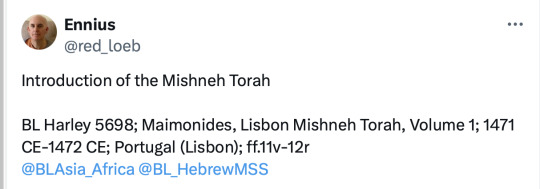#mishneh torah
Explore tagged Tumblr posts
Text


if anyone was ever worried
62 notes
·
View notes
Photo

Two knights clash at the border of the Mishneh Torah
Northeastern France, 1296
Dávid Kaufmann Collection #MS-A77, Oriental Collection at the Library of the Hungarian Academy of Sciences
700 notes
·
View notes
Text



25 notes
·
View notes
Text
"It is a mitzvah both to say what will be heard and not to say what will not be heard"
-Morá Carolina Dabah (Machon Ora Midrashet)
17 notes
·
View notes
Text
atonement
I realize only now that most, if not all, of my problems stem from the fact that I'm much more interested in worrying whether or not people like me than worrying about how my actions are impacting other people.
My priorities are wrong. "It is forbidden for a person to be cruel and not make amends."
"Five of them are things which the person who commits them drags with them perpetually, and they are all very bad character traits, and they are: (1) Slander. (2) Gossip. (3) Anger. (4) Someone who plots against their fellow. (5) Someone who makes friends with a wicked person, because he will learn from [the wicked person’s] ways and they will be inscribed in his heart."
#mishnehtorah
0 notes
Text
why are these two different authors using different mitzvot numbering systems
do you want to kill me
do you have any idea what this excel sheet looks like now. the arcane formulas i will have to use to parse this much talmud and like textually fuzzy compare different strings
so that i can organize and categorize the mitzvot into comprehensible blocks
if this excel sheet becomes sentient im submitting it to be a rabbi
#hashem help me#i am feeding an excel sheet the mishneh torah#i have linked the excel sheet to sefaria#i have linked it to chabad#what am i creating#look you gave an engineer 3000 years of data did you not expect me to try to parse it in excel#jumblr#jexcel
3 notes
·
View notes
Text
I’ve been researching religions & I have to say, I’m repeatedly shocked by Judaism.
Their bibles have morally repugnant teachings which have long been kept secret.
It says in Sanhedrin 59a “the punishment of a gentile who studies the Torah is execution.”
Their Talmud(Jewish laws) openly has two sets of justice, and says it’s ok to lie, cheat and steal from non-jews.
The Mishneh Torah says if a Jew rapes a 3 yr old non-jew, the baby should be executed for causing the Jew to rape her.
These books teach tribalism, deceit, a victim narrative, and supremacist mentality.
It’s being carried out to a T in Israel today.
The most insufferable part is how they commit atrocities while pretending to be the victims and then expect sympathy.
20 notes
·
View notes
Text
If one could speak of Biblical verses as being vilified, then "an eye for an eye" would be the most vilified verse in the Bible. It is commonly cited to "prove" the existence of an "Old Testament" ethic of vengeance, and then contrasted with the New Testament's supposedly higher ethic of forgiveness. "An eye for an eye" is often associated with modern Jews as well, and invariably in a pejorative manner. Israel's critics, for example, commonly accuse her of practicing "eye for an eye" morality when she retaliates against Arab terrorist acts.
In actuality, the biblical standard of "an eye for an eye" stood in stark contrast to the legal standards prevailing in the societies that surrounded the ancient Hebrews. The Code of Hammurabi, a legal code hundreds of years older than the Torah, legislated retaliation even against innocent parties. Thus, if A constructed a building for B, and the building collapsed and killed B's daughter, then A's daughter was put to death (Law number 229). The biblical law of "an eye for an eye" restricted punishment solely to the perpetrator. Furthermore, unlike Hammurabi's code, one who caused another's death accidentally was never executed.
"An eye for an eye" also served to limit vengeance; it did not permit "a life for an eye" or even "two eyes for an eye." The operative biblical principle was that punishment must be commensurate with the deed, not exceed it. Blood feuds and vendettas were long practiced among the Israelites' neighbors - indeed, they have persisted in the Middle East until this century - and revenge was often carried out without restraint.
Christian often contend that Jesus went beyond the standard of "an eye for an eye," that he advocated forgiveness and saw retaliation as unworthy of man. Yet the New Testament records Jesus saying, "But the one who disowns me in the presence of men, I will disown in the presence of my Father in heaven" (Matthew 10:33). In other words, Jesus seems to advocate treating others as they have treated him; a standard of justice that is perfectly commensurate with the demand of "an eye for an eye."
In the time of the Talmud, "an eye for an eye" was not carried out literally, and Orthodox Jewish scholars teach that it was never practiced. The Talmud's rabbis feared that the very process of removing the perpetrator's eye might kill him as well, and that, of course, would be forbidden (Bava Kamma 84a). "An eye for an eye" was therefore understood as requiring monetary compensation equivalent to the value of an eye. The same understanding was applied to almost all the other punishments enumerated in the same biblical verse, "a tooth for a tooth, a wound for a wound."
The only punishment in this set that was not converted to a monetary fine was capital punishment for murderers, "a life for a life." Because the Torah believed that premeditated murder deserved the death penalty, there was obviously no fear of punishing the killer excessively. Jewish law did dictate, however, that murderers be executed in the quickest manner possible. Hence, later Jewish law forbade the Roman punishment of crucifixion.
Torah law also forbade remitting a murderer's sentence with a monetary fine. Life and money, according to the biblical ethic, are incommensurate; one can never atone for murder by paying money. In this regard, too, Torah law differed from the laws of the ancient Jews' neighbors, which would sometimes fine those who had murdered people belonging to a lower social class and which made certain property crimes (for example, looting at a fire) capital offenses. In Jewish law, property crimes could never be punished with death, and murderers could never be let off with payment of money, even if the family of the victim were willing to accept it (see Numbers 35:31, and Maimonides, Mishneh Torah, "Laws Concerning Murder," 1:4).
Both in its insistence that evil must be punished and in its equal insistence on setting limits to that punishment, "an eye for an eye" is a basic principle of biblical justice.
- Jewish Literacy, Rabbi Joseph Telushkin, pages 558-560
#jewish literacy#rabbi joseph telushkin#an eye for an eye#the bible#the talmud#judaism#jews and judaism#jumblr
35 notes
·
View notes
Photo

The earliest depiction of people wearing costumes on Purim, from Sefer Zemanim (the Book of Holidays), in Maimonides’ Mishneh Torah. Original in Vatican City, Biblioteca Apostolica Vaticana. From northern Italy, ca. 1470. Image courtesy of Shalom Sabar.
Reminder that the Catholic Church looted, pillaged, rounded up, murdered, and committed atrocities against Jews while stealing our sacred and precious texts, including our art; much of which has not been returned.
306 notes
·
View notes
Text
youtube
In remembrance of Arnon Zamora. May his memory be a blessing to his family and all Israel.
“There is no mitzvah greater than the redeeming of captives.” Maimonides, Mishneh Torah
20 notes
·
View notes
Text
Last year, I hosted my biggest Rosh Hashanah dinner ever. My boyfriend and I invited about 15 friends over to our one-bedroom Brooklyn apartment, moved all of our furniture into the bedroom, rented a couple of folding tables and chairs, and turned the living room into a Rosh Hashanah dreamscape, complete with thematic streamers, ambient lighting, and candles. I whipped up four round challahs, a vat of vegetarian matzah ball soup, my mom’s famous cornflake kugel, some baked chicken, and a batch of spiked apple cider.
It was a lot of work, but absolutely worth it: I’m always sad when I can’t be with my family in Chicago during the High Holidays, but being surrounded by friends, some Jewish, some not, to celebrate Rosh Hashanah with food and drink was a warm, wonderful way to ring in the New Year.
But this year? Nah. I’m going with a pizza.
Of course we won’t be hosting another Rosh Hashanah dinner this year for the very obvious reason of a global pandemic. I know we could still make a special meal for the two of us with all the standard trappings that I grew up eating at my mother’s holiday table, but when I think about the work that that requires, and how exhausted I’ve been from merely existing in this current world, I just… kind of… don’t want to. I still want to mark the day as special, and I love the idea of eating symbolic foods on Rosh Hashanah, but I don’t want to spend an entire day cooking, and I certainly don’t want to spend an entire night washing dishes.
Which brings me to pizza, which I will henceforth argue is the perfect — and yes, symbolic — Rosh Hashanah food.
Why should pizza be considered a Rosh Hashanah food? Let’s dive in.
1. It’s round. Traditionally on Rosh Hashanah, instead of braiding challah into a traditional loaf, Jews bake their challah in a round shape to represent the circularity of the calendar and the never-ending cycle of life. You know what else is round? Yup, it’s pizza. Pizza might not be traditionally round for symbolic reasons, but it does allow for easy slicing and sharing, and sharing your food with others seems like a nice Jewish thing to do, no? And I’m not gonna lie: When I stare into a beautiful pizza pie, I see the entire universe staring back at me in all of its cheesy, saucy goodness.
2. It’s *possibly* a Jewish invention. Most people assume pizza came from Italy, but the cheesy delicacy actually has quite a complicated and debated history, with some even believing that the ancient Jewish philosopher Maimonides first coined the word. As Henry Abramson wrote in JTA, Yehuda Romano, a 14th-century Hebrew scholar from Italy, “translated Maimonides’ use of the word ‘hararah’ (a type of flatbread) in the Mishneh Torah with four simple Hebrew letters: peh, yud, tzadi and heh, or ‘pizza,’ arguably the very first time the word was ever used in any language.” In the “History of pizza” page on Wikipedia (a wonderful read if you’ve got the time), it’s noted that, “Some commentators have suggested that the origins of modern pizza can be traced to pizzarelle, which were kosher for Passover cookies eaten by Roman Jews after returning from the synagogue on that holiday, though some also trace its origins to other Italian paschal breads. Abba Eban has suggested that modern pizza ‘was first made more than 2000 years ago when Roman soldiers added cheese and olive oil to matzah.'” Look: I don’t know if Jews really invented pizza, but the chance that our people have been eating it for thousands of years is reason enough for me to order a fresh pie this Rosh Hashanah.
3. It goes well with honey. Honey is a traditional Rosh Hashanah food that represents the sweet New Year. Have you ever put honey on a pizza? What about hot honey? Just do it. Trust me. Moving on.
4. It’s already kind of a New Year’s food. Is it really a New Year’s celebration if you didn’t order pizza at 1 a.m.? Yes, I’m talking about that other New Year’s Eve, but the logic still applies. Plus, if you go a little too hard on that sweet kosher wine, you’ll be very happy to have a fridge full of cold leftover pizza the next morning.
5. Its numerical value is pretty meaningful. Okay, I can’t take credit for this one, and it’s a little out there, but bear with me: My colleague Ben Sales pointed out that according to Gematria, the numerological system by which Hebrew letters correspond to numbers, the Hebrew numerical value of “pizza” (פיצה) is 185. This is also the numerical value of the phrase “אני לדודי ודודי לי” which translates to, “I am my beloved’s and my beloved is mine,” which comes from a verse in the Song of Songs. This is kind of a slogan for Elul, the month leading up to the High Holidays. The idea is that this is a time period when we’re growing closer to God and vice versa. So let’s grow a little closer to pizza, too.
6. It’s just really good. I don’t know what else there is to say besides pizza is a perfect food, and why wouldn’t you want to start your New Year off with something so amazingly delicious? It’s been a tough year and we need comfort foods more than ever. We need takeout more than ever. We need to go easy on ourselves — and not add any unnecessary stress to our lives — more than ever!
If cooking up a storm on Rosh Hashanah makes you happy, then of course, you should go forth and do so. If you can’t imagine the High Holidays without some tzimmes and brisket, by all means, have at it. But if you’re looking for a way out of the norm during this very, very unusual year, I hereby grant you full permission to ditch the kitchen and call up your favorite local pizza place. Let them bring the party to you (and tip well!!). It’s just one of the many Jewish things to do.
16 notes
·
View notes
Text
Random Fact #6,493
"The god of Christians, Jews, and Muslims made only two genders" is not a sound claim even if we were to assume for the sake of argument that God exists and created genders.
Israelite society had several genders, not just two.
Ay’lonit [איילונית]
A person who is identified as “woman” at birth but develops “man” characteristics at puberty and is infertile.
There are 80 references to this gender in the Mishna and Talmud and 40 in the classical midrash and Jewish law codes.
Androgynos [אנדרוגינוס] (Ancient Israel, from at least 1st century CE to 16th century CE)
A person who has both “male” and “female” sexual characteristics.
There are 149 references to the gender in the Mishna and Talmud and a whopping 350 mentions in classical midrash and Jewish law codes.
Saris [סריס:] (Ancient Israel)
A person who is identified as a “man” at birth but develops “woman” characteristics at puberty and/or is lacking a penis.
A saris can be “naturally” a saris (saris hamah), or become one through human intervention (saris adam).
There are 156 references to this gender in mishna and the Talmud and 379 in classical midrash and Jewish law codes.
Tumtum [טומטום] (Ancient Israel)
A person whose sexual characteristics are indeterminate or obscured.
According to Maimonides’ Mishneh Torah, Mada, Avoda Zara, 12, 4 Tumtum is not a separate gender exactly, but rather a state of doubt about what gender a person is (kind of like a Schrödinger’s gender?).
#did you know#christianity#judaism#islam#random facts#random fact#little known fact#random factoid#random factoids#yes really#history facts#israelites#third genders#trans history#intersex history#lgbt history#religion#transgender#jewish culture#jewish history#abrahamic religions#god of abraham#god of israel#gender stuff#queer history
116 notes
·
View notes
Note
I have an image in my head of Beckett deciding to visit a creation museum just for the hell of it cuz he felt bored, and stands around bemused as he takes in the absurd exhibits and displays purporting to show that humans really did coexist with dinosaurs while the tour guide prattles on, unaware that before them stands a cursed, unholy creature of hell(tm).
As a scholar who doesn't believe in Caine I think he would find kine literalist interpretations of the Bible to be very amusing.
I didn't know creationist museums existed [searches DuckDuckGo] oh snap there's a famous one in Kentucky. Doesn't sound as fun as the Center of PostNatural History in Pennsylvania. No idea the connection between creationist belief and demons. A creationist may believe the world is young, but the appreciation of demonic booty is not.
Regardless, you've touched on a fun irony of Beckett. Our fav Noddist believes the story of Caine and Abel mythologizes the transition from hunter + gather society to settled agrarian society. I can't speak to Protestant sects, but today's Catholics and Catholic scholars also believe that. Adam, Eve, Cain, Abel, and Seth may have been literal, historical people, but it's impossible to know for sure. They for sure are narrative archetypes and play out the consequences of original sin (aka whatever triggered life to suck sometimes). Some scholars think Caine and Abel play out the tensions between nomadic desert tribes and the establishment of cities. Scholars propose that Caine founded the first city, but it was tiny and sucked major ass. Catholic Encyclopedia Answers here.
Another fun element of your proposed scenario is Beckett was definitely alive for Catholic scholars to go bananas about the Ussher chronology of earth. That's the one referenced at the beginning of Good Omens, if you've watched/read/listened to that. Some fucking nerd interpreted the Book of Genesis super literally so he could make Ye Official Timeline. Earth is a Libra. I bet Beckett hated Ussher with a passion 😂 He was probably SO glad when Ussher's ideas lost popularity.
Nowadays Catholicism has no official teaching on the age of earth, but there is an injunction to celebrate and uplift science and scientific thought: the findings of modern science "[...] have splendidly enriched our knowledge of the age and dimensions of the cosmos, the development of life-forms and the appearance of man. These discoveries invite us to even greater admiration for the greatness of the Creator, prompting us to give him thanks for all his works and for the understanding and wisdom he gives to scholars and researchers," (Catechism 283). The Cathechism is like this brick-sized synthesis of Catholic theology and morality. I think the closest Jewish equivalent would be the Mishneh Torah? It's a lot of Catholic Thought™️ brought back down to earth so the layman can look up references and specific questions.
In any case, World of Darkness dropkicks all progression of theological thought out the window and says Caine is literally real, literally a vampire, and literally wants to boink Beckett.
Thanks for the ask! This was fun to think about. I feel like you activated by Catholic trap card, haha.
#ask#chinesegal#text post#vampire the masquerade#vtm#beckett#cuthbert beckett#vtmb#vtm caine#world of darkness#wod#gangrel#clan gangrel#vtm beckett#beckett vtm#beckett vtmb#catholicism#center for postnatural history
12 notes
·
View notes
Text


73 notes
·
View notes
Text
As I mentioned before, it’s OK to turn up the heat from time to time, to call out, to castigate, even to cancel. What makes cancel culture problematic is not that it happens, but that we as a society do not provide an avenue for someone to return from it, to become uncanceled, to climb back into our good graces. And to learn how to do that, we need look no further than our sacred Jewish sources. For centuries, Jews have wrestled with notions of forgiveness. There is little question that our tradition speaks unequivocally about the need to forgive. In fact, so important is forgiveness that our Rabbis teach “one who overcomes their natural tendencies [to hold onto a grudge] and instead forgives [finds all his] sins are forgiven. (Rosh Hashanah 17a). However, not everyone who asks is deserving of forgiveness. Writing about the importance of forgiveness, Maimonides lays out the steps one must take before they can reasonably assume others will let them back in. He writes: The offended person is prohibited from being cruel in not offering forgiveness, for this is not the way of the seed of Israel. Rather, if the offender has [resolved all material claims and has] asked and begged for forgiveness once, even twice, and if the offended person knows that the other has done repentance for sin and feels remorse for what was done, the offended person should offer the sinner forgiveness (Mishneh Torah, Hilchot Chovel u-Mazzik, 5:10). Take a minute and notice what he says. Forgiveness is an imperative but only after a person is truly contrite. They may have to pay back money, they may have to try multiple times, they must prove that they have changed, but at that point it cruel not to bring them back. We move from the victim to the victimizer when we deny a person a pathway to redemption. Today, it’s not always easy to know if a person has authentically changed. We live in an era of canned apologies. Often the news cycle moves so quickly that a person can wait it out, assuming that people will forget about their missteps. Others will employ PR teams to remedy their tarnished image rather than face the hard work of actually earning back their community's trust. But most of us need and want to be forgiven and we are willing to take the steps to do that.
3 notes
·
View notes
